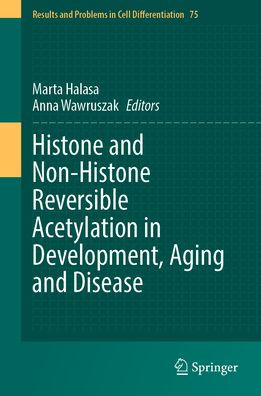It examines the biological consequences of modulating acetylation levels by histone acetyltransferases (HATs) and histone deacetylases (HDACs). Covered are manipulations at multiple levels, from in vitro and in vivo studies to clinical trials and FDA-approved therapies.
The book is divided in four parts:
• Part I provides an overview of post-translational modifications in the context of development, ageing, neurodegenerative and cancer-related diseases. It highlights the role of histone acetylation in higher genome organization and explores the functions of the proteins involved.
• Part II focuses on the modulation of cytoskeleton-associated proteins through reversible acetylation. It examines how acetylation influences cytoskeletal compartments, thereby regulating cellular structure and function.
• Part III examines acetylation in the context of development. It describes acetylation as a key regulator of early embryogenesis, influencing chromatin structure and gene expression.
• Part IV discusses physiological and pathological aspects of histone and non-histone protein acetylation and its modulation by activators and inhibitors.
The book is a valuable resource for scientists, clinicians and academic teachers alike.
It examines the biological consequences of modulating acetylation levels by histone acetyltransferases (HATs) and histone deacetylases (HDACs). Covered are manipulations at multiple levels, from in vitro and in vivo studies to clinical trials and FDA-approved therapies.
The book is divided in four parts:
• Part I provides an overview of post-translational modifications in the context of development, ageing, neurodegenerative and cancer-related diseases. It highlights the role of histone acetylation in higher genome organization and explores the functions of the proteins involved.
• Part II focuses on the modulation of cytoskeleton-associated proteins through reversible acetylation. It examines how acetylation influences cytoskeletal compartments, thereby regulating cellular structure and function.
• Part III examines acetylation in the context of development. It describes acetylation as a key regulator of early embryogenesis, influencing chromatin structure and gene expression.
• Part IV discusses physiological and pathological aspects of histone and non-histone protein acetylation and its modulation by activators and inhibitors.
The book is a valuable resource for scientists, clinicians and academic teachers alike.

Histone and Non-Histone Reversible Acetylation in Development, Aging and Disease
434
Histone and Non-Histone Reversible Acetylation in Development, Aging and Disease
434
Product Details
| ISBN-13: | 9783031914584 |
|---|---|
| Publisher: | Springer Nature Switzerland |
| Publication date: | 08/05/2025 |
| Series: | Results and Problems in Cell Differentiation , #75 |
| Pages: | 434 |
| Product dimensions: | 6.10(w) x 9.25(h) x (d) |
